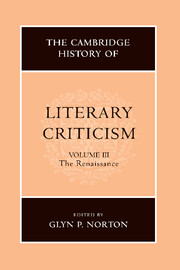Book contents
- Frontmatter
- Introduction
- READING AND INTERPRETATION: AN EMERGING DISCOURSE OF POETICS
- POETICS
- THEORIES OF PROSE FICTION
- CONTEXTS OF CRITICISM: METROPOLITAN CULTURE AND SOCIO-LITERARY ENVIRONMENTS
- VOICES OF DISSENT
- STRUCTURES OF THOUGHT
- NEOCLASSICAL ISSUES: BEAUTY, JUDGEMENT, PERSUASION, POLEMICS
- A SURVEY OF NATIONAL DEVELOPMENTS
- 56 Seventeenth-century English literary criticism: classical values, English texts and contexts
- 57 French criticism in the seventeenth century
- 58 Literary-critical developments in sixteenth-and seventeenth-century Italy
- 59 Cultural commentary in seventeenth–century Spain: literary theory and textual practice
- 60 The German-speaking countries
- 61 The Low Countries
- Bibliography
- Index
- References
61 - The Low Countries
from A SURVEY OF NATIONAL DEVELOPMENTS
Published online by Cambridge University Press: 28 March 2008
- Frontmatter
- Introduction
- READING AND INTERPRETATION: AN EMERGING DISCOURSE OF POETICS
- POETICS
- THEORIES OF PROSE FICTION
- CONTEXTS OF CRITICISM: METROPOLITAN CULTURE AND SOCIO-LITERARY ENVIRONMENTS
- VOICES OF DISSENT
- STRUCTURES OF THOUGHT
- NEOCLASSICAL ISSUES: BEAUTY, JUDGEMENT, PERSUASION, POLEMICS
- A SURVEY OF NATIONAL DEVELOPMENTS
- 56 Seventeenth-century English literary criticism: classical values, English texts and contexts
- 57 French criticism in the seventeenth century
- 58 Literary-critical developments in sixteenth-and seventeenth-century Italy
- 59 Cultural commentary in seventeenth–century Spain: literary theory and textual practice
- 60 The German-speaking countries
- 61 The Low Countries
- Bibliography
- Index
- References
Summary
In its broad outline and intellectual context, the history of literary theory and criticism in the Low Countries during the sixteenth and seventeenth centuries is not radically different from that of other parts of Europe. The fundamental presuppositions concerning the nature and function of serious literature, the division into genres, and, as Renaissance ideas strike root, the role of ancient models, are found here as elsewhere. The historical progression, too, shows a familiar pattern, as a high-prestige humanist culture spills over into vernacular writing, the willingness to imitate sources in other languages is followed by the emancipation of vernacular literature, and eventually the classical models make room for a post-Renaissance neoclassicism.
By and large, the number of writings on poetic or dramatic theory in the Low Countries during the Renaissance remained remarkably small (as was also the case with respect to art theory), and practical criticism was virtually absent until the 1670s. Nevertheless, the theorizing that took place shows a number of distinctive features. In mapping these it will be convenient to distinguish four successive periods. The first, from approximately 1470 to 1550, sees the dominance of the poetics of the so-called Chambers of Rhetoric. The second, from about 1550 to 1600, is marked by the absorption of new genres and ideas deriving from France and from the humanist republic of letters. The third, which runs from c. 1600 until c. 1670, shows the flowering of a self-conscious vernacular culture and the gradual waning of humanism as an innovative force.
- Type
- Chapter
- Information
- The Cambridge History of Literary Criticism , pp. 600 - 606Publisher: Cambridge University PressPrint publication year: 1999
References
- 1
- Cited by

